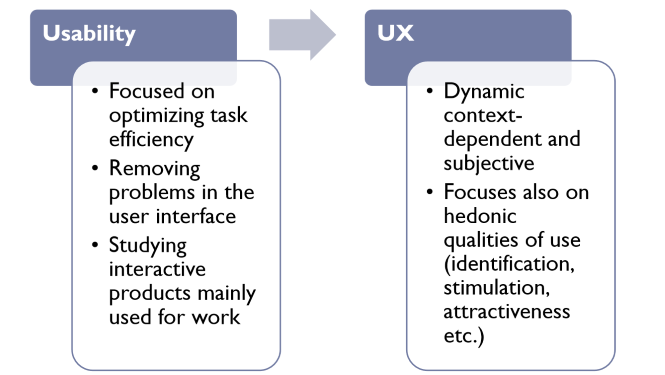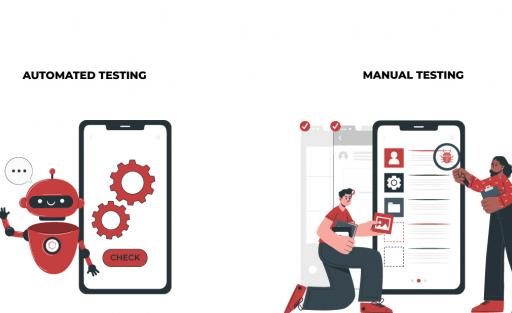From Usability to UX: A shift to hedonic aspects of interaction (part one)

Part One
In the first blog post we talked about the importance (sometimes neglected) of Usability. Now we turn into the big field of UX trying to see how this conversation was evolved from the concept of Usability to the so-called User Experience. The goal for this article (in 2 parts) is to briefly present the very basic considerations we have to go through as we are moving from Usability to User Experience. First let’s take a look on a widely accepted definition on UX as given by the ISO [1]: “A person's perceptions and responses that result from the use or anticipated use of a product, system or service”. According to this simple yet enlightening definition, UX focuses mostly on the subjective side of human computer interaction, users’ perceptions, thoughts and feelings. In addition temporality dimension is more than important; UX is a dynamic phenomenon and changes over time.
We could say that Usability focuses on the pragmatic qualities of use (i.e. interaction problem identification, user task effectiveness and efficiency etc.) while UX focuses more on the hedonic qualities of use.
All this discussion has started some years ago (decade or so) when the field of Human-Computer Interaction (HCI) expanded its perspective on the quality of interactive products. During the early years, HCI (aka the “ancestor” of UX) was originally being driven by a strong emphasis on user tasks, interactive computing systems mainly for work (e.g. organizational information systems) and productivity purposes and usability. Later (let’s say from mid and late 00’s), UX researchers and practitioners started to focus on issues like pleasure, beauty, emotions, etc. and all the other non-instrumental aspects of interaction that related to the hedonic quality of products and systems. In fact, such orientation was in parallel with the increasing focus on users’ psychological well-being and all the technology advancements of this time (web 2.0 and social media, launch of iPhone and smart phone technology etc.) that accelerated the emergence of UX.
For more on this important issue (hedonic and pragmatic quality of interactive products) we strongly suggest to read the relevant model by Marc Hassenzahl [2] [3].

As we shift to User Experience some of the main challenges for usability and UX practitioners are:
Challenge#1: There is a need for new approaches and methods. Some of the existing, traditional methods (although useful and valid) are somewhat unable to capture the whole spectrum of experience.
Challenge#2: The choice of UX evaluation method is a persistent challenge. Qualitative or quantitative methods?
Addressing these challenges is not an easy task. There is an open debate in the industry around these topics and a lot of academic research that is going on - especially for the development of new approaches and UX evaluation methods. We cannot provide definitive answers however the following issues/questions can help us out to frame these intricate problems.
- What Dimensions of Experience Are Studied?
- How do we measure UX?
- When to use which UX evaluation method?
- What about the time dimension?
In this first part we briefly discuss the first two issues.
What Dimensions of Experience Are Studied?
Several reports and case studies refer to the dimension of generic UX which usually includes both pragmatic (usability related) and hedonic dimensions. In addition and according to the focus of UX, it seems that emotional, affective and hedonic dimensions are very prominent: Enjoyment and fun, aesthetics, attractiveness and appeal, engagement and flow, motivation, enchantment, frustration etc. just to name a few.
How do we measure UX?
We could rephrase this question into “What are the methods applied in UX measurement?”
Actually it is not so easy to find any relevant fresh report for the industry measurement practices that covers the recent couple of years. However we could refer to the study of Bargas-Avila and Hornbaek [4] which was a systematic review on how empirical research on User Experience is conducted. This excellent study was published in 2012 but we can still use it as a reference since there is no strong evidence that there is a dramatic change nowadays. According to this study the qualitative methods were about 50 %, the quantitative 33%, and the combination 17%. Moreover it is important to see how UX data are collected. While user observation and video recording are quite common, the most widely used method was surveying, i.e. questionnaires and/or interviews. It is quite remarkable that the old traditional questionnaires are still the dominant UX evaluation method (53%). The popularity of surveys is also confirmed in the recent study by Jeff Sauro [5]. According to this new study, usability testing (both quantitative and qualitative) and expert reviews/heuristic evaluation (mostly qualitative) remain very popular.
In the Part Two we will discuss the rest important considerations.
Happy reading and keep on UXing!
References
[1] International Organization for Standardization (2009). Ergonomics of human system interaction - Part 210: Human-centered design for interactive systems. ISO F±DIS 9241-210:2009.
[2] Hassenzahl, M. (2003). The Thing and I: Understanding the Relationship Between User and Product. In M. A. Blythe, A. F. Monk, K. Overbeeke, & Wright, P. C. (Eds.) Funology: From Usability to Enjoyment (pp. 31-42). Dordrecht, The Netherlands: Kluwer.
[3] Hassenzahl, M., Diefenbach, S., and Göritz, A. (2010). Needs, affect, and interactive products - Facets of user experience. Interacting with Computers, 22, 5 (2010), 353-362.
[4] Bargas-Avila, Javier & Hornbæk, Kasper. (2012). Foci and blind spots in user experience research. Interactions. 16. 24-27. Available at: https://dl.acm.org/citation.cfm?id=2377790
[5] Sauro, J. The methods UX professionals use (2018). Available at: https://measuringu.com/ux-methods-2018/




